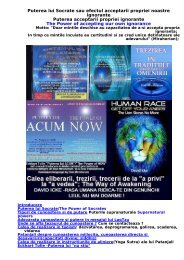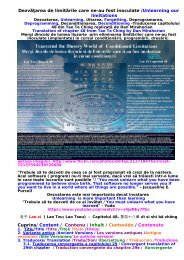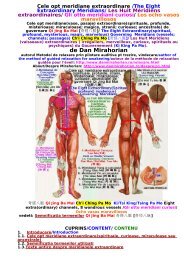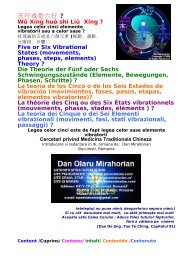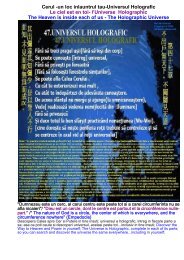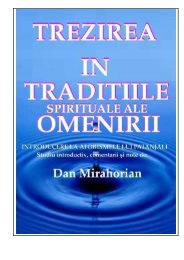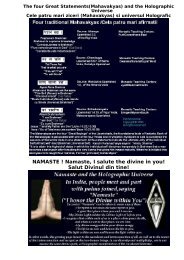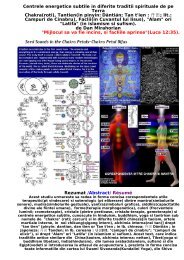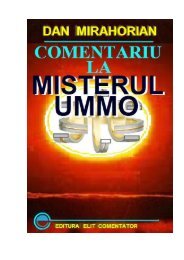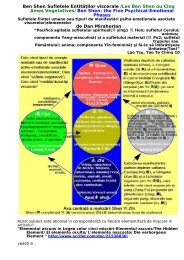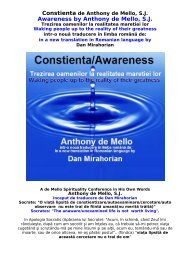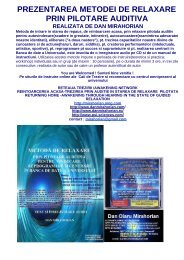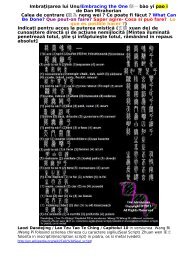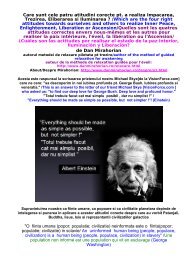Udana Vayu: localizare :gat si cap; centru ... - Dan Mirahorian
Udana Vayu: localizare :gat si cap; centru ... - Dan Mirahorian
Udana Vayu: localizare :gat si cap; centru ... - Dan Mirahorian
Create successful ePaper yourself
Turn your PDF publications into a flip-book with our unique Google optimized e-Paper software.
estimated to be not less than 109 c, where c is the speed of light. Secondly, tor<strong>si</strong>on<br />
fields are able to propa<strong>gat</strong>e in a region of space which is not limited by the light cone.<br />
That means that tor<strong>si</strong>on fielda are able to propa<strong>gat</strong>e not only in the future but in the<br />
past as well. Thirdly, tor<strong>si</strong>on fields transmit information without transmitting energy.<br />
Fourth - tor<strong>si</strong>on fields are not required to follow the superpo<strong>si</strong>tion principle [21].<br />
Tor<strong>si</strong>on or axial fields are generated by spin (con<strong>si</strong>dering clas<strong>si</strong>cal spin [22,23]) or by<br />
angular momentum. There exist both right and left tor<strong>si</strong>on fields (depending on the<br />
spin orientation). Since all substances (except amorphous materials) have their own<br />
stereochemistry which determines not only the location of atoms in molecules but also<br />
determines their mutual spin orientation, then the superpo<strong>si</strong>tion of tor<strong>si</strong>on fields<br />
generated by the atomic and nuclear spins of each molecule determines the inten<strong>si</strong>ty<br />
of tor<strong>si</strong>on field in the space surrounding each molecule. The superpo<strong>si</strong>tion of all these<br />
tor<strong>si</strong>on fields determines the inten<strong>si</strong>ty and spatial configuration of the characterist<br />
tor<strong>si</strong>on field of that substance. Thus each substance possess its own characteristic<br />
tor<strong>si</strong>on field.<br />
The property which is open to influence by tor<strong>si</strong>on fields is spin. (We should note that<br />
the spin-tor<strong>si</strong>on interaction constant is equal to 10 -5 - 10 -6. This constant is less than<br />
the constant of electromagnetic interactions, yet much greater than the constant of<br />
gravitational interactions.) Thus the structure of the tor<strong>si</strong>on field of every object can be<br />
changed by the influence of an external tor<strong>si</strong>on field. As a result of such an influence,<br />
the new configuration of the tor<strong>si</strong>on field will be fixed as a metastable state (as a<br />
polarized state) and will remain intact even after the source of the external tor<strong>si</strong>on<br />
field is moved to another area of space. Thus tor<strong>si</strong>on fields of certain spatial<br />
configuration can be "recorded" on any phy<strong>si</strong>cal or biological object.<br />
Since every permanent magnet possess not only oriented magnetic moments but also<br />
clas<strong>si</strong>cal spins orientation as well, then every permanent magnet possess it's own<br />
tor<strong>si</strong>on field. (This fact was first experimentally discovered by A.I.Veinik.)<br />
Understanding this important property of magnetic fields allows us to understand a<br />
variety of phenomena, for instance the phenomenon known as "magnetization of<br />
water".<br />
The following fundamentally important fact should be empha<strong>si</strong>zed. In the framework of<br />
the theory of electro-tor<strong>si</strong>on interactions, it is shown that if electrostatic or<br />
electromagnetic fields exist in some region of space, then there always exists tor<strong>si</strong>on<br />
fields in that region of space. Electrostatic or electromagnetic fields without a tor<strong>si</strong>on<br />
component do not exist. On the strict level this is shown by G.I.Shipov . Strong tor<strong>si</strong>on<br />
fields are generated by high electrical potentials and by devices with organized<br />
circular or spiral electromagnetic processes. (Probably the first researcher to<br />
investi<strong>gat</strong>e tor<strong>si</strong>on fields by this type of generators was Nikola Tesla. In Rus<strong>si</strong>a, <strong>si</strong>milar<br />
results were obtained by S.V.Avramenko and others.)<br />
Tor<strong>si</strong>on fields can be generated as the result of the distortion of geometry of the<br />
phy<strong>si</strong>cal vacuum. Every object with a certain surface geometry will <strong>si</strong>multaneously<br />
generate left and right tor<strong>si</strong>on fields of a certain configuration depending on the<br />
geometry of the object. This fact can be detected by various types of phy<strong>si</strong>cal,<br />
chemical and biological indicators. This type of manifestation of the tor<strong>si</strong>on field was<br />
repeatedly observed by numerous researchers: A.I.Veinik, Yu.V.Tszyan Kanchzhen,<br />
A.A.Beridze-Stakhovsky, V.S.Grebennikov, I.M.Shakhparonov and many others in<br />
Rus<strong>si</strong>a and various researchers in other countries [25-31]. Later an experimental<br />
investi<strong>gat</strong>ion of the tor<strong>si</strong>on fields generated by objects with different geometry of<br />
surface was conducted by the group of A.E.Akimov at the Phy<strong>si</strong>cs Institute of the<br />
Ukraine Academy of Sciences and at Chernovitsky Univer<strong>si</strong>ty .<br />
Another kind of tor<strong>si</strong>on generator employs a combination of the above described<br />
principles. For instance, the combination of high-frequency electromagnetic<br />
oscillations and topological effect ("form effect") is used in the generators developed<br />
by Yu.V.Tszyan Kanchzhen. The combination of high electric potential and topological<br />
effect is used in the device made by A.I.Veinik and in the device described in the<br />
patent [27]. The combination of magnetic fields and high-frequency electromagnetic



